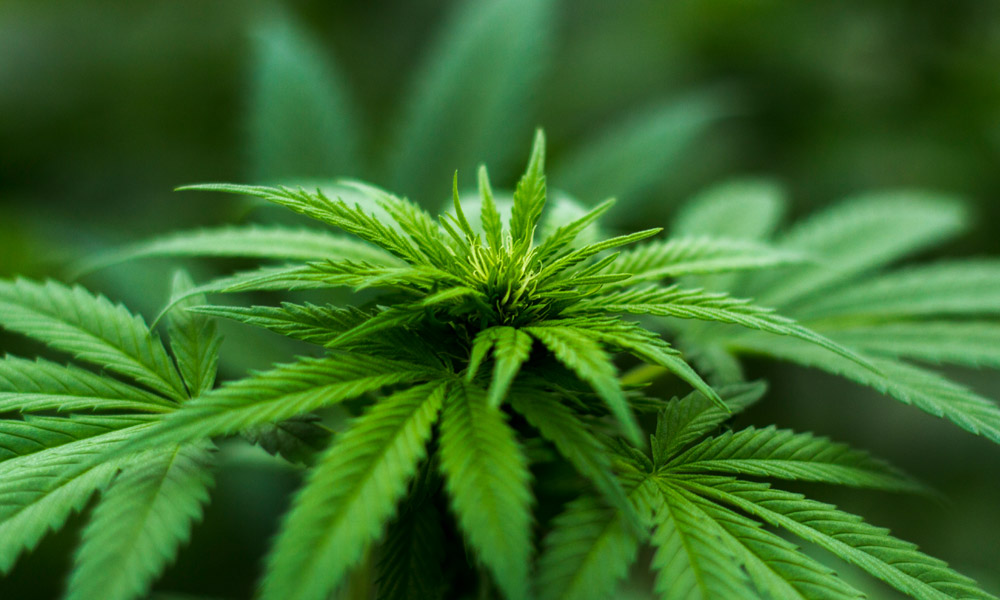
TEN YEARS AGO, Zach Walsh was a newly-minted psychology professor at UBC’s Okanagan campus. With an extensive background researching substance use and criminality in the United States, Walsh was arriving in British Columbia at an interesting time.
The conversation around cannabis had recently shifted in much of the western world, as if emerging from a long, dark winter. After a decades-long stigma that had begun with “Reefer Madness”—a 1930’s propaganda film that alleged marijuana use caused insanity and violent behaviour—and culminated with the ineffective and potentially disastrous U.S.-mandated ‘War on Drugs’, the public seemed ready to have a new conversation around cannabis.
In BC, long known for its more liberal views of cannabis use compared to the rest of Canada, the timing seemed just right.
“I arrived at UBC Okanagan just when the first dispensaries were opening up in Kelowna and spreading across BC,” says Walsh, an associate professor in the department of psychology.
“I looked at this burgeoning new field and decided to take some of what I knew about substance use and apply it to this medical cannabis world. Once I got started, it seemed like I was part of a wave.”

Walsh saw the potential to use cannabis to treat things such chronic pain and anxiety, and give a greater quality of life to people who were on opioids or other medications.
Walsh admits he initially thought he’d be more focused on dispelling some of the myths around the harm associated with cannabis use. After all, he’d worked with hard-drug addicts and violent criminals in US prisons, so he could certainly agree with the growing chorus of voices who now seemed to be saying more loudly and frequently that maybe using cannabis wasn’t all that bad after all.
What Walsh didn’t expect was that during the next decade, his research would not only address the misinformation around the harm of cannabis use, but would take a serious and sober look at the many potential benefits of using cannabis.
 “When I first got involved in the medical cannabis world, I was quite surprised when I found the potential therapeutic uses of cannabis,” says Walsh. “Previously, I’d always thought of cannabis along the lines of decriminalization and harm reduction, but seeing the potential to use it to treat things like chronic pain and anxiety, giving a greater quality of life to people who were on opioids or other medications, I didn’t anticipate that.”
“When I first got involved in the medical cannabis world, I was quite surprised when I found the potential therapeutic uses of cannabis,” says Walsh. “Previously, I’d always thought of cannabis along the lines of decriminalization and harm reduction, but seeing the potential to use it to treat things like chronic pain and anxiety, giving a greater quality of life to people who were on opioids or other medications, I didn’t anticipate that.”
Walsh—often fielding questions from national and international media, consulting with government and training the next generation of cannabis researchers—now finds himself part of a network of fellow academics, researchers, students, governments and industry partners who are looking at ways new and beneficial uses for cannabis.
With legalization now reality, Walsh and his team of UBCO graduate student researchers continue to put their foot on the pedal. Having been given a preview of the types of data generated in legal-pot states such as Colorado, they are excited about the removal of barriers and the research potential that lies before them.
Read more about Zach Walsh
Cannabis has long been maligned as an addictive narcotic that could lead to serious health issues. While that concern is not without merit, increasing numbers of people are using cannabis as a substitute for prescription drugs and alcohol, according to a 2015 UBC and University of Victoria research paper.
“Our study shows that more than 80 per cent of medicinal cannabis users reported substituting cannabis for prescription drugs including opiate pain killers,” says Walsh, who is the primary investigator of the Cannabis Access for Medical Purposes Survey (CAMPS), the largest Canadian survey of medical cannabis patients to date.
“If you want to make informed choices about pain control, I think use of cannabis is a right that every Canadian should have.”
The CAMPS study, which provided data on cannabis substitution, was supported with a grant from UBC Okanagan’s Institute for Healthy Living and Chronic Disease Prevention.
Subtitled “The Impact of Contextual Factors,” Walsh and his team’s study also found that 51 per cent of the 473 respondents report substituting cannabis for alcohol, and 33 per cent suggest they use cannabis instead of illicit substances like cocaine and crystal meth.
“If you want to make informed choices about pain control, I think use of cannabis is a right that every Canadian should have. It’s been proven to be much less harmful and addictive than opiates or substances like alcohol.”
Against the backdrop of a growing overdose epidemic, another study co-authored by Walsh finds that a majority of chronic pain sufferers preferred cannabis to prescription opioids, providing growing evidence of the role medical cannabis can play.
“This study,” he says, “is one of the first to track medical cannabis use under the new system of licensed producers, meaning that all participants had physician authorization to access cannabis in addition to their prescription medicines.”
The study tracked more than 250 patients with prescribed medical cannabis—people treated for conditions such as chronic pain, mental health and gastrointestinal issues. Overall, 63 per cent of respondents reported using cannabis instead of their prescription drugs, which included opioids (to treat pain), benzodiazepines (sedatives) and anti-depressants.
The study, published in International Journal of Drug Policy, was funded by Canadian medical cannabis producer Tilray.
As Canada adjusts to legalization, the debate continues on how to best implement and administer recreational cannabis. After some provinces announce they will distribute cannabis through the provincial liquor boards (to mixed reviews), Walsh and other prominent researchers add their voices.
“Dispensaries do serve a role in our society, especially for some people with chronic illnesses who use cannabis for medicinal purposes,” says Walsh. “There is a self-regulatory model that already exists and improvements can be made in a legalized environment.”
“Dispensaries provide a proven, valuable service.”
“Dispensaries are not new and they provide a proven, valuable service,” says PhD student Rielle Capler. “While some are thought of as a nuisance, in reality many of these dispensaries are small, independent, long-standing businesses who serve a dedicated clientele.”
While operating under the shadows of provincial laws and city bylaws, dispensaries have thrived in neighbourhoods across Canada. Capler calls the current method a “natural experiment” that’s been underway for decades. She says lawmakers should this keep in mind when addressing regulation policies.
 UBC Okanagan biology and chemistry professors teamed up with researchers from Thompson Rivers University and an industry partner to find other potential cannabis bio-products—from pharmaceuticals to nutritional products to industrial fibre.
UBC Okanagan biology and chemistry professors teamed up with researchers from Thompson Rivers University and an industry partner to find other potential cannabis bio-products—from pharmaceuticals to nutritional products to industrial fibre.
Dubbed the Cannabis Bio-products Toolbox, the collaborative research project explores the vast range of bio-products that can be made from the multifunctional plant.
“Cannabis is a source of many potentially valuable products,” says biology Professor Michael Deyholos. “But because of its prohibition over the past decades, development of new products from cannabis has lagged behind other crops.”
“Besides pharmaceutical compounds, there are healthful oils and proteins in the seed that we would like to enrich.”
Deyholos, whose research explores the potential of flax and hemp, says on the medicinal side of cannabis there are dozens of compounds in the plant that may have specific health benefits. The researchers want to breed strains that are enriched in various combinations of these compounds, tailored to needs of specific patients.
“Besides these pharmaceutical compounds, there are healthful oils and proteins in the seed that we would like to enrich,” he says. “All of this requires a better understanding of the genes and chemicals already present in different strains of cannabis, and that is what this project is designed to do.”
Deyholos says while cannabis is best known as a source of THC—tetrahydrocannabinol, the principal psychoactive ingredient—the plant produces at least 90 other cannabinoids, many of which have potent biological activities. Some of these compounds are being examined for the treatment of cancer, Parkinson’s disease, and other serious health conditions.
Prof. Susan Murch is a Canada Research Chair in Natural Products Chemistry. Her research team from UBC Okanagan, in collaboration with BCIT, is developing and validating an accurate method for analyzing cannabinoids in cannabis raw materials and finished products that is more efficient than current practices and uses fewer toxic solvents.
With an explosion in the number of labs analyzing cannabinoids in marijuana, existing methods are inefficient, require expert analysts, and use large volumes of potentially environmentally damaging solvents.
The Next Generation: Students discuss cannabis research
Not only is cutting-edge research into cannabis being conducted at UBC, but the next generation of cannabis researchers are emerging in the Okanagan.
With areas of study including harm reduction, cost-substitution and even pre-natal care (all related to cannabis of course), these talented young academics are poised to make a big impact in coming years.

Kim Crosby
1st year PhD student in Clinical Psychology
Areas of research: Cannabis and the “substitution effect,” PTSD

Sarah Daniels
1st year master’s student in Clinical Psychology
Areas of research: Cannabis and pre-natal care, cannabis and yoga

Tatiana Sanchez
1st year master’s student in Clinical Psychology
Areas of research: Cannabis and social norms

Michelle Thiessen
2nd year master’s student in Clinical Psychology
Areas of research: Cannabis and harm reduction, acute and chronic pain
Thiessen:
For a long time, I’ve been fascinated by the history of drugs, the counter culture and human behavior. I actually came to a talk by Dr. Walsh on cannabis before I even decided to pursue post-secondary education. Until that point I hadn’t realized that it was possible to formally study these things. It feels serendipitous that there has been this paradigm shift that seems to have broadened the scope of research allowing me to look at recreational and therapeutic cannabis use, not just problematic use.
Sanchez:
Cannabis wasn’t something I had previous research experience with. My research background was in neuroscience, personality and public health. I’m originally from Colombia, but I moved with my family to New York and then Toronto. I did my psych undergrad at McGill and worked as an RA in Montreal before deciding to come to UBCO. Specifically, I’d worked with depression screening tools. But I saw the opportunity here so decided to come to UBCO and study clinical psychology and cannabis
Daniels:
I think people would be surprised at the high rates of therapeutic cannabis use during pregnancy, but it’s done on the “down low” because of the stigma around it. When I tell people that I am researching prenatal cannabis use, the assumption tends to be that I am focused on the potential harms. A common perception seems to be that prenatal cannabis use is primarily recreational, and that pregnant women should be able to stop for nine months for the health of their unborn babies, similar to drinking alcohol.
But that overlooks the therapeutic and medical potential of using cannabis. For example, cannabis seems to be uniquely effective in treating morning sickness, especially severe morning sickness, which can be very dangerous for the health of both the mother and the fetus.
Thiessen:
For chronic pain, cannabis is really effective—in fact, it’s one of the most prominent conditions treated with cannabis. However, the research suggests that for acute pain, it might be less effective. That could suggest that cannabis is helping with your mood, sleeping, etc. and less so the actual pain itself.
It’s still too early to know for sure, but some previous studies have found that when people are “high,” they are more sensitive to pain and it’s typically more intense. Interestingly, opioid use has been shown to increase sensitivity to pain as well. I wanted to see if frequent cannabis use led to a similar increase in pain sensitivity.
Crosby:
I’m very excited (legalization) will come during my research. I think a lot of it will come down to cost. We know that changing the cost of things can have a significant impact on behaviour. We’ve seen this with cigarettes, where increased prices led to fewer smokers. I’m interested to see the prices of cannabis, how it matches up with alcohol and if that will cause people to significantly choose cannabis over alcohol. Of course, we know that there are other factors such as desired effect.
Daniels:
It’s going to be a lot easier to conduct research on cannabis after legalization, and the types of studies we can conduct will open up dramatically. Right now, the cost and effort it takes to get ethics approval to conduct many types of research on cannabis is a pretty big barrier. Once cannabis is legal, we should have a lot more freedom for research in human populations.
Sanchez:
I think it will definitely be less stigmatized. Because the government approves of it. Going forward, my hope is that we’ll find an interesting pattern and that can help inform how we teach adolescents to interact with cannabis. We know from alcohol that even though cannabis will be prohibited to those under 18, many are likely to try it.
Thiessen:
So much research to date has been limited to animal studies. I came across one the other day with a headline, “Marijuana significantly lowers the I.Q. of adolescents.” I looked closer and saw the study was conducted with mice—I think everyone can agree that humans are slightly more complex. I think legalization will mean that we can start conducting this research with humans. It will be interesting to see if what we think we know about cannabis holds true.
Crosby:
Yeah, I mean… my friends and family all know now, but at the start I got some questions. I think in general, the stigma is decreasing. More people are becoming more knowledgeable about cannabis. We’ve been fielding a growing number of questions about our work from other academic institutions, but they’re still cautious.
Daniels:
There are definitely a lot of strong opinions around cannabis. A lot of people draw a line between recreational and medical use, but I think there’s a big window in between, and use takes place on a spectrum. Do you have to be seriously ill to want to feel better? A lot of cannabis use takes place more centrally on the continuum between recreational and medical use, such as decreasing stress and increasing well-being. There is also a misconception that studying cannabis use is studying smoked cannabis, an opinion that all smoking is bad so cannabis must be bad, too. However, there are several ways to deliver cannabis including ingesting it and using cleaner vapourizing methods.
Crosby:
We’re in a unique position here. There’s a community in Kelowna, the Okanagan and at UBCO of people curious about cannabis and open to exploring its effects. Work has been very well received by the university. We’ve had lots of collaboration with other institutions and community contacts that has been very beneficial in producing research here.
Sanchez:
Studying at UBCO has a lot of great opportunities and benefits. We have a TA who works with us one-on-one and I know some of the equipment we get to use is pretty expensive. A lot of other programs I was looking at didn’t have those same resources. I’m used to living in big cities but I’m really happy with my choice to come here. I’m definitely planning to stay for my PhD.